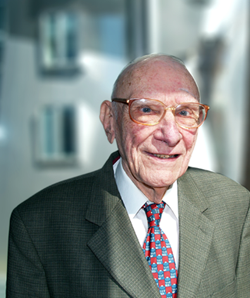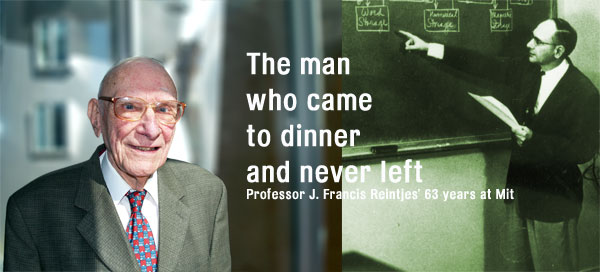Since its first incarnation as the Servomechanisms Lab of the 1940s, LIDS has changed names, location, and personnel, yet retained a character all its own. Professor J. Francis “Frank” Reintjes is a living witness to that history. He joined MIT during World War II, took over leadership of the Servo Lab in 1953, saw it become the Electronic Systems Lab in 1959, and stayed on as director until 1974. Reintjes has long been retired, but maintains his office in EECS and works to preserve and document the lab’s history. LIDS-All was privileged to meet with him on two occasions and learn about his experience as director, his beginnings at MIT, and a few of the lab’s seminal projects.
LIDS history is longer and more complex than one article. As Reintjes points out with a laugh, “you’ve got a bear by the tail there! Sixty-five years worth of the laboratory is a lot.” However, books and other materials are available that provide more detailed information,* and the MIT Libraries and Archives are a great resource. We hope that Reintjes’ stories will inform and inspire a new generation of students, faculty and staff who call the lab home.
When he talks about his career at MIT, Reintjes describes himself as “the man who came to dinner and never left.” It all began when he attended an Institute for Radio Engineers meeting in New York in the early 1940s. During the coffee break he and Dr. W.L. Barrow of MIT struck up a conversation, at which point Reintjes was invited to join a new radar training school at the Institute. He applied for and was given a leave of absence from his position at Manhattan College and joined MIT in 1943, intending to return to New York after. “Except that I didn’t go back, ever,” he says, chuckling.
Reintjes left MIT only once after 1943, and that was to spend a year working for General Electric in Schenectady, NY, in 1946. Recalling that year – and why he came back to MIT afterwards – Reintjes jokes that he’d “been used to the idea that if I wanted to get a haircut at 10:30 in the morning, I’d walk across the street and get it. But you don’t do that in industry. ... I didn’t like that kind of strict regimen.” Drawn back to the world of academia, he returned to MIT in the spring of 1947 with a faculty appointment.
Just a few months later, Reintjes attended his first commencement as a professor, which at the time was held in Boston’s Symphony Hall. He recalls that June day in 1947 as particularly memorable. “In those days the Institute was very rank conscious,” he explains, so at commencement the professors lined up according to both rank (full, associate, assistant, and so on) and year of appointment. Being the newest member, Reintjes was the last man in line. He was so new, in fact, that the stage was one chair shy. He laughs and says he was “standing in the middle of the stage, and no place to go. … The only thing I could do was sit down on the floor behind an organ console, and hide, really, from everybody else. So help me, the only thing I saw of that commencement was occasionally some guy’s feet playing the organ.” Afterwards he filed out with the other faculty, having missed most of the ceremony, and “got talking to this very nice gentleman.” When he saw the cover of the Boston Globe that night, he learned he’d been talking to none other than the commencement speaker, Senator Flanders from Vermont.
Reintjes worked at MIT five years following that first commencement before he took over as director of the Servo Lab, founded in 1939 by Prof. Gordon Brown in response to a US Navy request for a special course in servomechanisms and fire control. Reintjes himself didn’t know of the Servo Lab’s existence at first. In 1952 he was conducting research in RLE and finishing up a book on radar, when he was approached by Dr. Brown about directing the Servo Lab. Reintjes recounts that he “almost blew it” by asking Brown what that lab was. “It was Brown’s pride and joy, you see,” he explains. Reintjes stopped short, however, and said he needed a day to think about it. He asked colleagues who told him it was “the one-story building out behind the main building. Gordon Brown’s lab.” At that point he realized, as he puts it, that he’d “better take it.” He took over its leadership in 1953 and stayed on for 21 years.
Reintjes refers to the early Servo Lab as a kind of “military job shop,” where the emphasis was on quickly responding to military needs, especially applying feedback control to gun-positioning systems. The nature of the work meant, he explains, that the “the whole environment was different at that time. The lab was not so academically oriented, [with] little emphasis on graduate theses and publication.” Even towards the end of the war and shortly after, that attitude was dominant. Its WWII origins continued to affect the lab in other ways, too. Projects started during WWII often continued and evolved after the war. Reintjes names the “Whirlwind” computer as a key example. Professor Jay Forrester began Whirlwind as a specialized digital computer for simulating the 3-axis control of aircraft. The computer was never used for that purpose, however, but for a variety of other applications, particularly air defense projects. Yet without its initial sponsorship by the military, it may not have come to fruition.
With so many projects still connected to the military, the transition from the early lab to what Reintjes calls “the academic engineering research lab” was not immediate. For one thing, “we couldn’t declassify that lab immediately,” he explains, “because of contractual commitments with the military.” However, certain projects like those related to numerical control were never classified, so the lab’s building was separated into two parts. “Access was easy” to the open area, recalls Reintjes, but anyone who wanted to enter the rest of the lab needed security clearance. Gradually, more projects were declared unclassified, and the composition of research in the laboratory evolved. The lab became increasingly academic in nature, and there was a definite trend toward students doing graduate projects. “Many of them for a while were Masters, but then we turned out our first doctoral thesis,” Reintjes explains. When he took over as director, “it was an engineering research lab, but I thought we should have some theoretical background going on ... As a result, we made an effort to add faculty.” Among the first to join was Michael Athans, who later became lab director. A number of other people joined the faculty in the first ten or fifteen years of his directorship, including Profs. Leonard Gould, George Newton, and Jan Williams, along with Alan Willsky and Sanjoy Mitter, who later also served as lab director. Both he and Prof. Willsky are still at LIDS.
As the scope of its research broadened, the Servo Lab was renamed the Electronic Systems Laboratory in 1959. An important post-WWII project that propelled this evolution was the first numerically controlled milling machine. It debuted in 1952 and led to a revolution in the machine tool industry. Being able to automatically control the machine meant that mechanical parts of intricate shape could be produced quickly and reliably. Operating the machine was relatively simple, but as Frank Reintjes recalls, machinists were not receptive at first. “The information to build a part was keyboarded into a paper tape machine,” he explains, “so when it came time to run the milling machine, all the machinist had to do was feed in the tape.” The new method seemed strange, he recalls, and “the old time machinists were scared to death that something would go wrong.” So the engineers tried a different tactic. They brought in a business student from Harvard, sat him in front of the milling machine, and gave him the operating instructions. Reintjes smiles and says, “Well, he believed us. He just sat there and grinned and didn’t do anything. He was one of our best machine operators, and he was a business school candidate.”
The larger machine tool manufacturing industry also needed convincing. After the introduction of the milling machine, lab members worked extensively to communicate the advantages of the new system, holding conferences in order to demonstrate the technology. The intent, Reintjes affirms, was “to give them confidence in what these machines would do.” The belief in this kind of “information transfer” was key to the lab and Reintjes’ own philosophy as director. He points out, “we couldn’t manufacture these tools ourselves,” so they asked the important question: how do you get the ideas out, and establish a new industry? This idea remained important to Reintjes with future projects, and has shaped and influenced the LIDS of today.
After Prof. Athans took over leadership of the lab in 1974, Reintjes continued at MIT but became, as he puts it, “less coupled to the lab.” He had other things to do, he jokes, one of which was Project INTREX, a program of “information transfer experiments” designed to change the way information is stored and retrieved in libraries. The project was conducted under the leadership of Professor Carl Overhage, with members from both Project MAC and the Electronic Systems Laboratory, and Reintjes as its technical head. INTREX resembled an early version of today’s electronic catalog systems. Reintjes remembers that a team of researchers hand-picked 1,000 documents to catalogue and put into a computer, which users could then view on either cathode-ray tubes or microfiche. The genesis for Project INTREX came from the idea that general-purpose computers could be used to help locate research in professional literature; an idea that now seems commonplace, but was revolutionary then. The team worked with students who needed information for their term papers or theses, and Reintjes recalls, “It was very successful. We learned how to put keywords in that were very meaningful; not just 2, 3, or 4 to describe a document, but 10, 15, or 20.” The Internet, of course, now supersedes this system, but Reintjes notes, “it’s a good example of how you break ground for new technology.” INTREX demonstrated that “finding information through technology was going to be important.” Reintjes concludes that you never know what direction your work might take. “Same old story,” he says, “the current-day Ford automobile bears no resemblance to the old Model T. ... People take what you’ve done and build on it.”
Though it’s been twenty-eight years since his retirement, Reintjes maintains an active presence at LIDS and in EECS. He’s a wealth of information about the lab’s roots, and continues to participate in the community. Not only does he come into his EECS office weekly, but he can also be seen attending occasional lab events. Friendly, funny, and inspiring, Frank Reintjes has made a lasting impact on LIDS. His legacy certainly won’t be forgotten.




